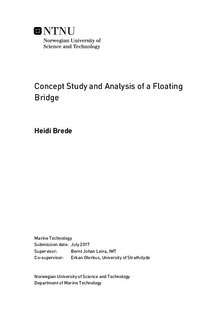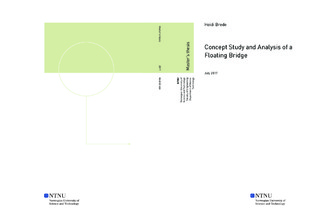| dc.description.abstract | A floating bridge is a structure carrying traffic across a body of water and whose supports floats
on the surface. The history of the floating bridge goes as far back as around 2000 BCE, when
their use was mainly military. Today, several large floating pontoon bridges help relieve traffic in
and out of large cities and populated areas. In Norway, the National Public Road Administration
(NPRA) have made plans to build floating bridges across two large fjords to replace the ferries
that currently ship traffic across. One of these fjords is Bjørnafjorden, for which the NPRA have
come up with a few different concept solutions for crossing. One of these concepts was chosen
for this study to look closer at static and dynamic responses.
The model of the concept bridge was created in ANSYS 17.1, and several different analyses were
performed; modal, static, regular wave and irregular sea state for three storm conditions. The
main aim was to determine the dynamic response of the bridge in waves, to ensure traveller s
safety and comfort even during certain storm conditions. Criteria included limitations to maximum
accelerations in y- and z-direction, and maximum rotations about the x-axis.
The modal analysis showed that some vertical and horizontal eigenfrequencies of the bridge
may coincide with environmental loads and could potentially be of concern. The static analyses
with environmental and traffic loads showed that the bridge would remain structurally safe for
maximum traffic and winds and currents with a 100-year return period. Of some concern were
the responses to the regular wave analyses, as the results showed little coherency and were larger
than expected. The reason for this was somewhat unclear, and the responses to regular waves
should be studied further. The results from the irregular sea states were more consistent and
showed that the bridge would be safe for traffic during storms with a 1-year return period. For
more severe storms with return periods of 10 and 100 years the extreme responses exceeded the
criteria limits, and would therefore not be deemed safe for traffic. This was not considered to be
of concern, however, as the NPRA for safety reasons close bridges when wind speeds exceed 25
m/s, which they are likely to do during these storms. | |

